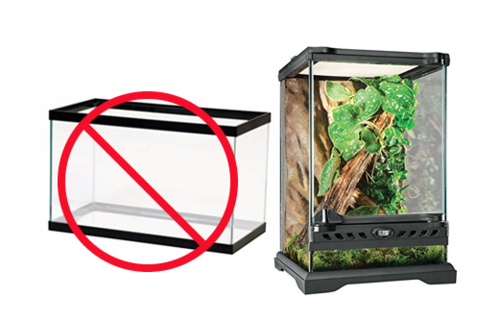jjherps
New Member
Hello all!
I am very interested in some discussion regarding the Trioceros genus in captivity from some experienced keepers. I am fascinated by this genus and really want to start keeping them, but I have some questions and concerns I would like to have some clarification on.
It is my understanding that most if not all Trioceros sp. are from higher altitudes and thus require lower temperatures and high humidity. What stands out and I find interesting is people saying that a big night time drop in temperature is necessary for them to function correctly (from ambient high of 26c day to 15c or even lower at night?). I understand the need for a night time drop because of their geographical range in the wild but the numbers I have been seeing don't seem practical or possible for the average keeper? Yet many people keep them and they are available to buy CB from breeders.
A contradiction I have found interesting is that Trioceros jacksonii xantholophus cannot live without the large nighttime drop in temperature, yet they are a pest and thrive in Hawaii which is completely different to where they naturally occur. I am sure they have night time drops but surely it is not as extreme?
I would really like some experienced responses from people who actually keep the species successfully and not just regurgitated facts from the top google search (no offence intended).
Here are my main questions I have:
-What in your experience are the acceptable temperature ranges for trioceros sp. that you work with?
-Which trioceros sp. is best in captivity in terms of hardiness, ability to handle warmer temperatures etc.
-Opinion on keeping pairs/trios of trioceros together in large vivaria. I have read that it is more possible then it is with veileds/panthers.
-Everywhere I read seems to suggest that screen cages are the only way to keep these chameleons successfully. What is your opinion on this? I keep other reptiles that are described as similarly sensitive and they are not kept in screen cages. There is always more then 1 way to crack an egg if you know what I mean!
I am a seasoned reptile keeper and know how to setup enclosures correctly for humidity/temperature/basking/airflow etc, but of course there are limits to what is practical in the home. I live in an apartment so no underground cold basements for me to utilize. I now live in Sweden and of course it gets cold here but we warm our home more then 15c in the winter.
Greatly appreciate if you have time to reply with any knowledge you would like to share
I am very interested in some discussion regarding the Trioceros genus in captivity from some experienced keepers. I am fascinated by this genus and really want to start keeping them, but I have some questions and concerns I would like to have some clarification on.
It is my understanding that most if not all Trioceros sp. are from higher altitudes and thus require lower temperatures and high humidity. What stands out and I find interesting is people saying that a big night time drop in temperature is necessary for them to function correctly (from ambient high of 26c day to 15c or even lower at night?). I understand the need for a night time drop because of their geographical range in the wild but the numbers I have been seeing don't seem practical or possible for the average keeper? Yet many people keep them and they are available to buy CB from breeders.
A contradiction I have found interesting is that Trioceros jacksonii xantholophus cannot live without the large nighttime drop in temperature, yet they are a pest and thrive in Hawaii which is completely different to where they naturally occur. I am sure they have night time drops but surely it is not as extreme?
I would really like some experienced responses from people who actually keep the species successfully and not just regurgitated facts from the top google search (no offence intended).
Here are my main questions I have:
-What in your experience are the acceptable temperature ranges for trioceros sp. that you work with?
-Which trioceros sp. is best in captivity in terms of hardiness, ability to handle warmer temperatures etc.
-Opinion on keeping pairs/trios of trioceros together in large vivaria. I have read that it is more possible then it is with veileds/panthers.
-Everywhere I read seems to suggest that screen cages are the only way to keep these chameleons successfully. What is your opinion on this? I keep other reptiles that are described as similarly sensitive and they are not kept in screen cages. There is always more then 1 way to crack an egg if you know what I mean!
I am a seasoned reptile keeper and know how to setup enclosures correctly for humidity/temperature/basking/airflow etc, but of course there are limits to what is practical in the home. I live in an apartment so no underground cold basements for me to utilize. I now live in Sweden and of course it gets cold here but we warm our home more then 15c in the winter.
Greatly appreciate if you have time to reply with any knowledge you would like to share







